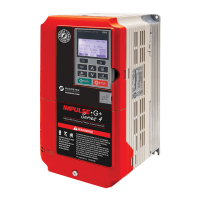IMPULSE
®
•G+ & VG+ Series 4 Technical Manual
November 2020
Page 210
6.2 Troubleshooting Encoder Related Faults
The faults in this section may involve the encoder feedback system. During system startup, these faults are often
caused by parameters that need to be adjusted. However, after the system has been running for some time without
a fault, this usually indicates a problem with the physical system and adjusting the parameters should only be done
after the physical system has been inspected.
6.2.1 Fault Code: DEV–Speed Deviation Fault
6.2.1.1 Definition
A speed deviation fault means that the VFD output is not able to follow the commanded speed reference. This is
possible if there is not enough torque available to follow the internal speed reference. Therefore, speed deviations
will typically occur when the VFD is at its programmed torque limit. In addition, if the VFD receives erratic, or
missing, encoder pulses, speed deviations are also possible. If the initial VFD tuning and start-up of the system
was successfully completed and the crane has been in operation without any faults, then the occurrence of this
fault most likely indicates that something mechanical with the system has changed or VFD parameters were
changed (i.e., failed encoder, load snag, crane overload, change in acceleration or deceleration times, etc.).
6.2.1.2 Corrective Action
1. Do NOT continue to operate the hoist.
NOTE: Continued attempts to operate the hoist with speed deviation faults occurring can result in loss of control of
the load under certain circumstances.
2. As a precaution the load float time, parameter C08-10 should be set to zero until the source of the speed
deviation fault has been determined and corrected.
3. Verify if the load has snagged or if there is a load on the hook that exceeds capacity.
4. Check the alignment of the encoder pulse wheel with the sensor head, or the encoder shaft coupling
(depending on the type of encoder used). If the pulse wheel is misaligned or the shaft coupling is loose the
VFD will get erratic pulse signals or no signals at all causing a speed deviation fault or PGO (Pulse Generator
Open) fault. Repairs to the encoder wheel or shaft coupling should be made immediately before again
attempting to operate the hoist.
5. If the encoder appears to have no mechanical problems, the encoder cable should be checked for damage and
replaced if a problem is found.
• Each of the encoder wires should be checked for continuity.
• The wires should be checked for shorts between any two wires.
• The wires should be checked for shorts to the shield or ground.
• Visually inspect the cable for damage that may be causing intermittent problems.
6. If the encoder feedback system checks out mechanically and electrically, then the last physical check to make
is for something in the mechanical system that might be resisting normal operation. One example may be the
brake is not opening fully and is causing enough drag to prevent the system from operating at commanded
speed.
7. If the encoder feedback system checks out and no other mechanical problems can be found, then something
must have changed in the control system.
• Check if the acceleration or deceleration times have been changed (B05-01, B05-02, C01-02, C01-04, or
C01-05).
• Check if a function that provides an alternate acceleration or deceleration rate has been enabled or
changed (Quick Stop, Reverse Plug Simulation, Accel/Decel Time 2).
If one of these times is too short, causing torque limited acceleration or deceleration, then the times should be
extended.

